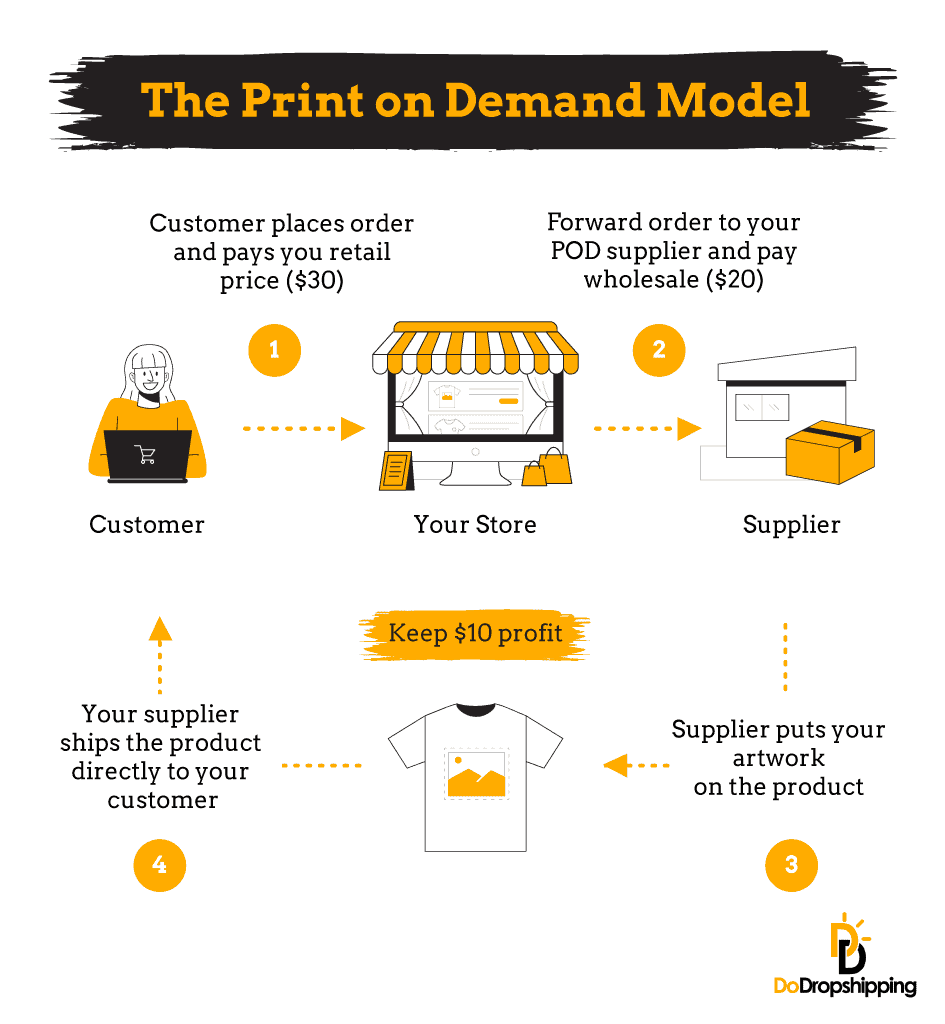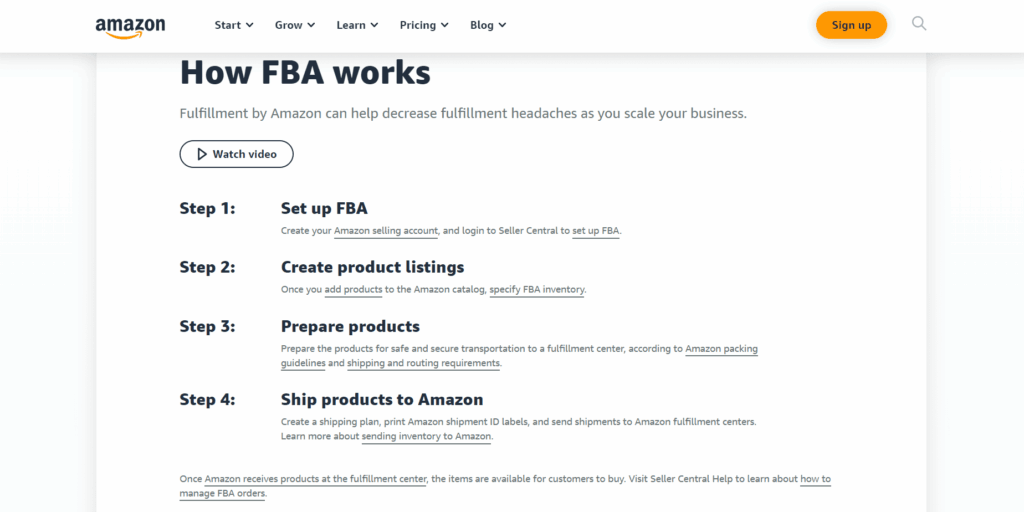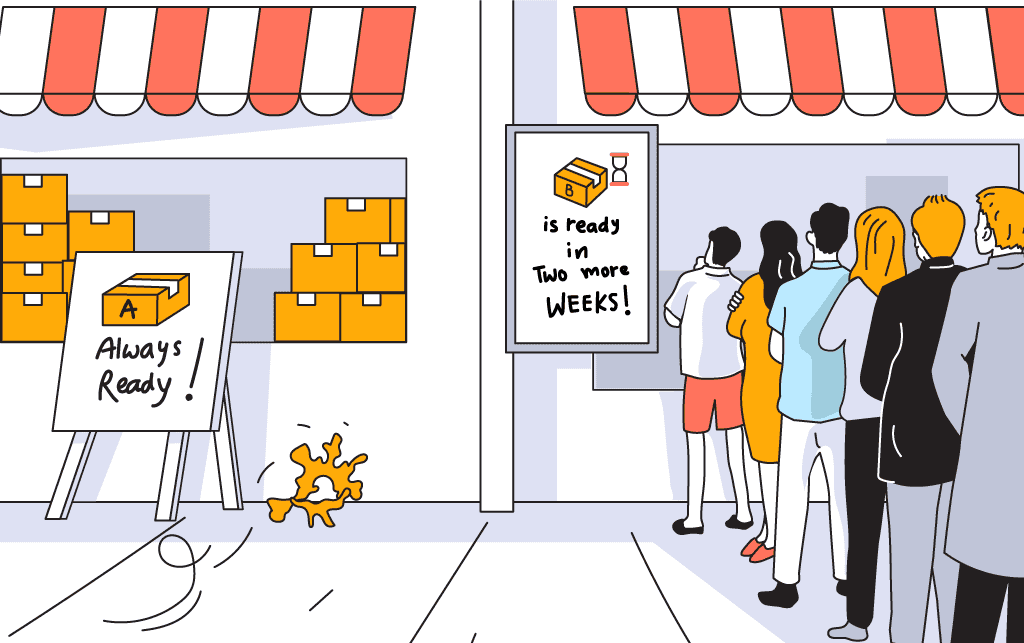Have you ever thought of starting an online store but felt held back by the thought of dealing with inventory?
Well, we have some good news.
It's totally possible to start an online store without having to stock a single item yourself!
In this guide, we will discuss six ways to sell products online without dealing with inventory.
Let's start!
6 Ways to start an online store without inventory
The six ways to start an online store without inventory are:
- Dropshipping
- Print on demand
- Digital products
- Affiliate marketing
- Third-party logistics (3PL)
- Amazon FBA
Let's start with the first:
1. Dropshipping
If there is one business model that comes to mind when starting an online store without inventory, it's dropshipping.
That's because it literally fits in our definition of dropshipping:
Dropshipping is an ecommerce business model in which you sell products on an online store without inventory. Instead, you partner with a dropshipping supplier who stores the products you sell and ships them directly to your customers.
If this sounds confusing, don't worry; it's actually quite simple!
Here's how the dropshipping model works:
- You start your own online store.
- You find a dropshipping supplier and list their product(s) on your store.
- Once you get an order on your store, you place that same order with your supplier.
- Your supplier ships the product(s) directly to your customer.
And for visual learners, here's an infographic that explains it as well:

Most people use Shopify to start a dropshipping store:

Tip: Have you already created your Shopify account? If not, sign up by clicking this link here to get a free 3-day trial + 1 month for $1!

Next, you need a dropshipping supplier.
Dropshipping suppliers can store and pack your products and ship them directly to your customers. They send the product in blank packaging, meaning your customers won't know that a third party is involved.
There are even dropshipping apps like Spocket or DSers designed to send any new orders to your supplier automatically.
One of the key benefits of dropshipping is that you can start selling a wide range of products online without investing in inventory.
It allows you to test many unique products without any upfront costs!
And for this reason, dropshipping is a popular option for people starting to sell products online.
It's a relatively low-risk and low-cost way to launch a new ecommerce business!
Here is an overview of the pros and cons of dropshipping:
| Pros | Cons |
| Low startup costs. | The dropshipping mindset. |
| Quickly test products without an inventory. | High competition. |
| Your supplier handles shipping and logistics. | Less control over shipping and product quality. |
| Starting a new store doesn't take long. | Profit margins can be slim. |
| It's possible to start earning profits in the short term. | Refunds can be complicated. |
| Difficult to build a brand identity. |
Overall, dropshipping is an excellent option for those looking for an easy way to get started in ecommerce.
Yes, dropshipping, in general, has more cons than pros.
However, there are always methods to deal with those cons and make them less apparent! (You can find more about these methods here.)
For example, by starting a private label dropshipping store, you can brand your products to differentiate yourself from the competition!

If you are interested in starting a dropshipping store, you may want to sign up for our free 7-day challenge.
It's a step-by-step guide that will help you create a dropshipping store in just seven days.
Alternatively, you can also check out our dropshipping checklist here!
2. Print on demand
Have you always dreamed of selling products that you've designed yourself?
If so, you can do it with print on demand (POD).
And the great part is, you don't need to keep an inventory for it!
Print on demand is a business model where you create a design and put it on a product in your online store. When a customer makes a purchase, your print on demand supplier prints your design onto the product, packs it, and ships it directly to your customers.
Here is an infographic on how it works:

As you can see, print on demand is one of the closest alternatives to dropshipping!
Products sold in POD stores are often apparel such as shirts and hoodies. But you can also sell products like mugs, towels, art prints, phone cases, and even notebooks or mousepads!

Here are the pros and cons of the print on demand business model:
| Pros | Cons |
| A POD store is as easy and low-risk to set up as a dropshipping store. | POD businesses generally struggle with tight profit margins. |
| Ability to (partly) design products yourself. | Dealing with returns can be more challenging as the product is custom-made. |
| You will never have to deal with any leftover inventory. | Your store is only as good as your designs. |
| Often, you don't have complete control over the product's look. |
The main difference between dropshipping and print on demand is that with dropshipping, your supplier doesn’t make any changes to the product, and the shipping time is generally longer.
With print on demand, your supplier creates the product according to your custom design, and the shipping time is generally longer.
Here's an infographic that summarizes all the differences:

If you are an artist or graphic designer and would like to learn more about the print on demand business model, take a look at the following articles:
- Is Print on Demand Still Profitable Today in 2024?
- How to Start a Print on Demand Business in 2024 (8 Steps)
3. Digital products
This one may be very obvious to you, or it may be a total surprise!
When most people think of starting an online store, they typically think of selling physical products like phone cases or clothing.
However, you can also sell digital products!
Selling digital products means you're dealing in goods that can be sold, downloaded, and used entirely online. Examples include ebooks, courses, software, music, photography, templates, and more.
For example, Shopify’s Business Name Generator is an example of a digital product in the form of software:

However, this ebook about getting great ideas is also a digital product:

And there are many more kinds of digital products!
Just think about things like Shopify themes or stock photos.
The best thing about selling digital products is that there are no production or shipping costs – once you create the product, you can sell it infinite times without ever needing to restock.
You set up your online store, list your digital products, and when someone makes a purchase, they receive a link to download or access the product online.
It's as simple as that!
Here are the pros and cons of selling digital products:
| Pros | Cons |
| It doesn't cost you anything extra to sell an additional digital product (once it's developed). | Someone can easily copy and sell your digital products without your permission. |
| You are in complete control of the pricing. | Digital products may require ongoing support and maintenance. |
| Digital products can instantly be sold and delivered to anyone with an internet connection. | Marketing digital products can be more difficult. |
4. Affiliate marketing
Affiliate marketing is a strategy that allows you to sell products without inventory and, in many cases, without even creating your own products!
Have you ever clicked on a link for a product or service from a blog, social network, or someone's website?
Well, it could've been an affiliate link!
Affiliate marketing starts with signing up for an affiliate program offered by a company whose products you want to promote. Once accepted, you'll receive a unique affiliate link that tracks sales from your marketing efforts. You can share this link on your online store. When someone clicks on your link and makes a purchase, you earn a commission.

So, with affiliate marketing, you do the marketing part, and someone else takes care of all the rest!
According to statistics, 31% of web publishers say affiliate marketing is a top revenue source, and 81% of brands offer affiliate marketing programs!
If you want to get started with affiliate marketing, there are several ways to promote your affiliate links and earn commissions.
You can share affiliate links on an online store, a blog, or social media channels!
For example, you could create a tennis blog, write an article like 'The best tennis rackets to use in 2024,' and add affiliate links to Amazon product pages for each item:

Here are the pros and cons of affiliate marketing:
| Pros | Cons |
| After the initial hard work of setting up your affiliate marketing channels, this business model can turn into a passive income. | You must respect the terms and conditions of the affiliate marketing program you cooperate with. |
| You don't have to think about customer support. | It may take a while to build up a significant income. |
| Starting an affiliate marketing business does not require a significant upfront (money) investment. |
Tip: If you are in doubt about this and dropshipping, you can learn about the differences between affiliate marketing and dropshipping here!
5. Third-party logistics (3PL)

If you like the idea of selling physical products but dread the thought of dealing with the daily hassles of fulfillment, Third-party logistics (3PL) might be what you're looking for.
It's a model that sits in between completely inventory-free strategies and traditional stock management.
With third-party logistics, you send your products to a 3PL provider, and they store them in their warehouse. When an order comes in, the 3PL company picks, packs, and ships the product directly to your customer.
Below is an overview table of the pros and cons of 3PL:
| Pros | Cons |
| A good 3PL company can easily handle increased order volumes. | The fees for 3PL services can be hefty for small order volumes. |
| 3PL providers know how to store products safely and ship them quickly. | You have less control over the handling and shipping process. |
| You can dedicate more time to other business tasks. |
6. Amazon FBA

Last but not least is Amazon's Fulfillment by Amazon (FBA).
FBA lets you sell your products directly on Amazon using its world-class logistics network.
With Amazon FBA, you send your products to Amazon's fulfillment centers, where they're stored until an order is placed. Amazon then picks, packs, and ships the products on your behalf. They also handle customer service and returns for these orders.

Here are the pros and cons of Amazon FBA:
| Pros | Cons |
| Products fulfilled by Amazon are eligible for Amazon Prime, which means faster shipping for customers. | Amazon charges for storage and fulfillment, which can cut into your profit margins. |
| Take advantage of Amazon's vast customer base. | Selling on Amazon means competing with many sellers, including Amazon itself. |
| Amazon's fulfillment centers are equipped to handle large order volumes. | While Amazon handles customer service, this also means you have less control over the customer's experience. |
| You can easily sell your products in different countries without worrying about international shipping logistics. |
Pros of starting an online store without inventory
- Low startup costs. You don't have to purchase hundreds of products beforehand. This makes it more accessible to start.
- Sell a wider variety of products. You're not limited by the amount of physical space you have.
- Flexibility to test. Selling without inventory means you can easily test which products resonate with your audience.
- No risk of being stuck with leftover inventory. If you stop selling a particular product, you don't have to worry about getting rid of excess inventory.
- More time to focus on the rest of your business. There's no need to pack, ship, and manage your inventory.
- Easier to scale. When your store takes off, scaling up doesn't involve calls to wholesale suppliers or renting bigger storage spaces.
- Work from anywhere. All you need is a laptop and an internet connection, and you're in business!

Cons of starting an online store without inventory
- Lower profit margins. Buying products one by one will always be more expensive than buying them in bulk.
- Potentially longer shipping times. If your supplier is far from your customers, you may experience longer shipping times.
- Quality control issues. You must trust your supplier to sell high-quality products and perform quality control before shipping to your customer!
- Dependance on third-party suppliers. Your store's reputation is in the hands of your suppliers. If they run out of stock or decide to increase prices, you have a problem to solve.
- High competition. Due to the low barriers to entry, standing out requires extra creativity in marketing, branding, and customer service.
- Limited customization. Since you're buying products one by one, there's often no possibility of customizing a product to your brand.
How do you open an online store?

Whether you want to start dropshipping, sell digital goods, or offer unique POD products, opening an online store always involves several key steps.
Here are the nine steps of starting an online store in 2024:
- Pick your preferred ecommerce platform
- Choose a fulfillment method
- Decide between a general, niche, or one-product store
- Pick out the right products to sell online
- Define your ideal target audience
- Find a supplier
- Design and brand your online store
- Set up your payment gateways
- Promote your store with social media and content marketing
You can learn more in our in-depth guide to starting an online store!
FAQs about selling online without inventory
Is there something keeping you on edge to start an online store without inventory?
If so, your question may be answered below!
Can you sell online without inventory?
Yes, you can sell online without holding inventory. Several business models enable this, including dropshipping, print on demand, selling digital products, affiliate marketing, 3PL services, and Amazon's FBA program.
How do I start a Shopify store without inventory?
Starting a Shopify store without inventory typically involves choosing a business model like dropshipping or print on demand. You can learn more about the required steps in our Shopify-specific guide here.
How do you sell on Etsy without inventory?
Selling on Etsy without inventory often involves using the print on demand or dropshipping model or selling digital products. You can learn more about the required steps in our Etsy-specific guide here.
Can I sell on Amazon without having inventory?
Yes, you can use dropshipping, print on demand, digital products, or Amazon's FBA program to sell on Amazon without inventory.
Summary
Before we go to the conclusion, we've created a quick summary of this article for you so you can easily remember it:
- You can start an online store without inventory using dropshipping, print on demand, selling digital products, affiliate marketing, third-party logistics, and Amazon FBA.
- The main pros of starting an online store without inventory are that you don't have to make a significant investment or worry about being left with excess inventory.
- The main cons of starting an online store without inventory are that you may experience lower profit margins and longer shipping times.
Conclusion
Starting an online store without inventory can be a great way to start a business as a beginner.
You don't have any inventory costs, such as warehouse rental and staff, and you can offer a broader range of products.
However, it is also essential to consider the potential downsides of this approach, such as lower profit margins and longer shipping times.
Good luck with everything!
Want to learn more about ecommerce?
Ready to move your online store to the next level? Check out the articles below:
- How to Start an Online Niche Store in 2024 (7 Tips)
- Dropshipping Mindset: 6 Things to Know Before You Start
- How to Sell Products Online Without Inventory (4 Methods)
Plus, don't forget to check out our in-depth how to start an online store guide here.










